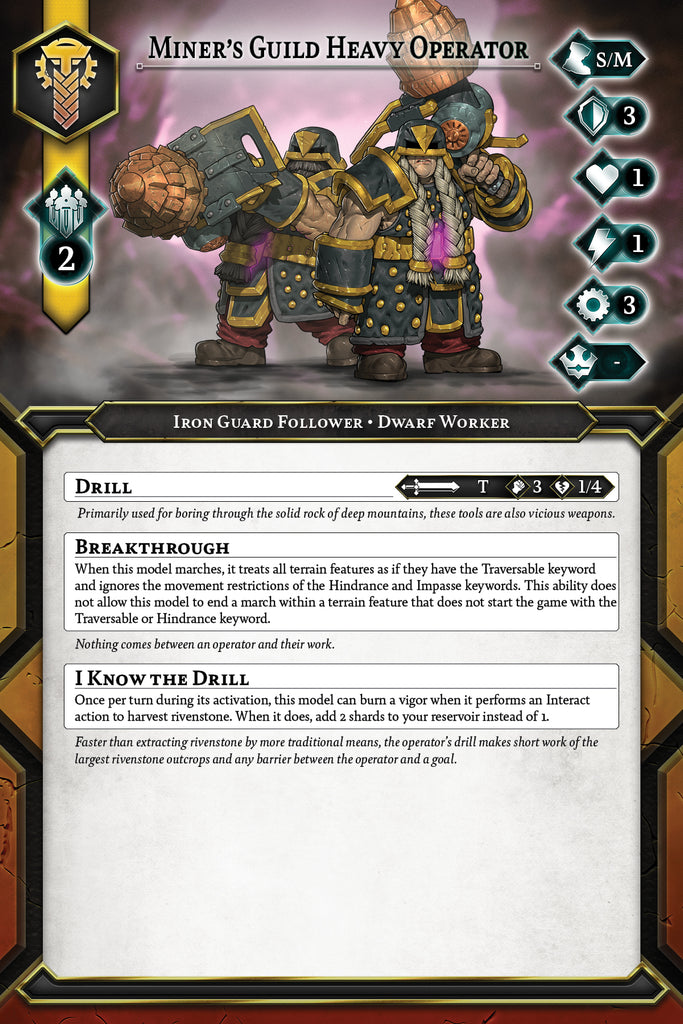Welcome to the twelfth installment of our introductory Rivenstone gameplay series. These blogs are meant to cover some of the basic rules of the game, giving you a taste of what the tabletop experience will be when the game launches later this year.
If you’re just joining us, you can find previous blogs exploring the gameplay as well as the fiction of Rivenstone on our website.
Be the first to know when we release our future posts in our gameplay blog series by signing up for our newsletter on our site and by following our social media accounts on Twitter, Facebook, and Instagram.
Now that we’ve shown you the stat cards for all the models in the Shattered Empire, Orrix, and Risen starter boxes, it's time to round things out with a look at the Iron Guard starter box.
There will be plenty other models launching with Rivenstone outside of those found within the starter boxes, and we’ll be covering those very soon as well!

The Iron Guard Warband

The Iron Guard forces are led into battle by Director Hobart Cragden, who strides into conflict atop his minewalker. Hobart’s skill and efficiency in rivenstone mining is second-to-none. So great is his genius at the craft of mining, he is capable of predicting rivenstone flows before they erupt, swiftly directing his workers to capitalize on the resource and deny enemy forces their share of the claim. Director Hobart has a powerful subordinate working in tandem with him, the Weldmonger. Together these two models constitute the hero selection for this Scouting Party-sized warband.
(click to enlarge)
(click to enlarge)
(click to enlarge)
(click to enlarge)
A quick look at the two heroes in the warband immediately indicates what their primary game plan is in regards to scoring victory points: control the rivenstone.
This is a common theme throughout Iron Guard heroes, with many of them scoring based on their interactions with rivenstone deposits.
Both Hobart and the Weldmonger are capable of scoring their secondaries consistently each turn. The Weldmonger is a hero that can score victory points with zero random chance of failure, which is particularly powerful. A common first turn set of activations for this warband is to have the two Heavy Operators mine a nearby deposit 2-3 times, thanks to the Weldmonger’s Master Plan ability followed by the Weldmonger activating and infusing. As long as the operators harvested while within the Weldmonger’s Leadership range, that’s an easy 2 victory points scored right out of the gate.
Hobart takes a little more work to score his secondary, but not much, and in the process of scoring he’s achieving things you want to be doing anyway; specifically harvesting shards and killing enemies.
The real strength of Hobart comes in the power of his Harpoon Rifle and the truly disgusting debuff Drainage. There are not many effects in the game that allow you to move enemy models with ranged attacks, and none that allow you to move them closer to your army. Hobart can pull enemy models out of position with ease. A couple of hits on an enemy hero and you can drag them directly into the heart of your army to be dealt with by the rest of your forces (or the crushing jaws of Hobart’s minewalker).
In many scenarios, especially those where the rivenstone deposits are clumped up close to one another, Hobart’s Drainage ability is far more brutal than any of Belcroft’s shard stealing tricks. Placing Hobart in the right position to keep him safe, popping Drainage, and flat denying your opponent the ability to gain any shards either through Interact actions or eruptions can completely choke out their access to the strongest resource in the game … all while your own models gain upwards of 6 to 8 shards a turn.
(click to enlarge)
The followers in this warband fall into two very different and specialized roles. Tunnel Fighters are this warband’s frontline troops. The Fighters are a highly versatile unit, with all three of their abilities being relevant at various stages in the game.
Their Pistol weapon has solid Range, good Strength, and can allow for some movement shenanigans when the Tunnel Fighter hits but doesn’t kill an enemy model (such as an enemy hero). Their other weapon, Lumen Grenades, may not deal any damage but they are the perfect way to help set up a kill on a tougher enemy. The Tagged condition allows you a one-time reroll of any number of skill dice when attacking.
Finally, their Signal Rounds ability means that, similar to the Risen Death’s Door ability, as long as a single Tunnel Fighter has made their way up the board your opponent must always be concerned that you’ll simply spawn more followers near their side of the table. In many ways this is even more powerful than the Death’s Door ability, as it doesn’t require a barracks action and allows you to continue applying pressure with the other Tunnel Fighters you activate.
The Miner’s Guild Heavy Operator is the pinnacle of what a worker-style follower is capable of. They aren’t really made for combat, and with a muster of 2 and only 1 Health they aren’t an elite unit like Orrix Brutes. What they lack in combat prowess, however, they make up for with being the best rivenstone harvesters in the game.
With Ingenuity 3 they will rarely ever fail a harvest roll to suffer damage, and their I Know the Drill ability means you will be swimming in rivenstone shards. Most scenarios require models to move up the board a bit to access rivenstone deposits, but there are a few with at least one deposit closer to a player’s table edge.
The Mother Lode scenario is a good example of this;, it's the tutorial scenario and has two deposits per table edge very close to each player’s deployment zone. In this scenario, the Operators can deploy within range to harvest deposits immediately. This means, if they have a Weldmonger nearby, and they each burn 2 Vigor (1 for a free Interact action and 1 for double shards from I Know the Drill), that you can net 8 shards in a single follower activation. Dwarves really are the best at rivenstone harvesting!
We’ve shown the Breach Head barracks before, but now that you’ve had a chance to see the special abilities of the other faction’s barracks you can appreciate how unique the Iron Guard one is. It doesn’t spawn followers far upfield like the others; instead, it is capable of moving itself.
This movement means that each time you invest the shards and actions into doing so, you are making later respawns stronger by having more of your warband appear right in the middle of the action. A real sneaky trick is that barracks can’t be targeted, damaged, or affected in any way … but they do still count as models in regards to controlling objectives. If you’re willing to give up some tempo early on by sacrificing hero or follower activations to take barracks activations, you can eventually have an indestructible model sitting on an objective, potentially scoring it each turn.
The last thing we have to mention for this warband is their coalition ability. You’ll notice that all these dwarves are rather slow, with their typical Speed of Short / Medium. However, the Iron Guard Mining Operator coalition completely changes this.
Like other mono-faction coalitions, it requires that over half of the heroes in your warband are Iron Guard models. It’s coalition ability reads:
When an Iron Guard model in this warband is spawned, it can immediately perform a free Walk action.
That means each time a model spawns from the barracks (which might have moved upfield), and each time a model is spawned by a Tunnel Fighter’s Signal Round, they get a free Walk.
Imagine moving the barracks 2-3 times during the course of the game, getting it closer to the center of the board, then respawning a bunch of your dwarves. They would immediately spread out across the board and establish scenario pressure!

Thank you for joining us for this week’s installment of the gameplay blog series. Join us again next week as we dive further into more rules!









